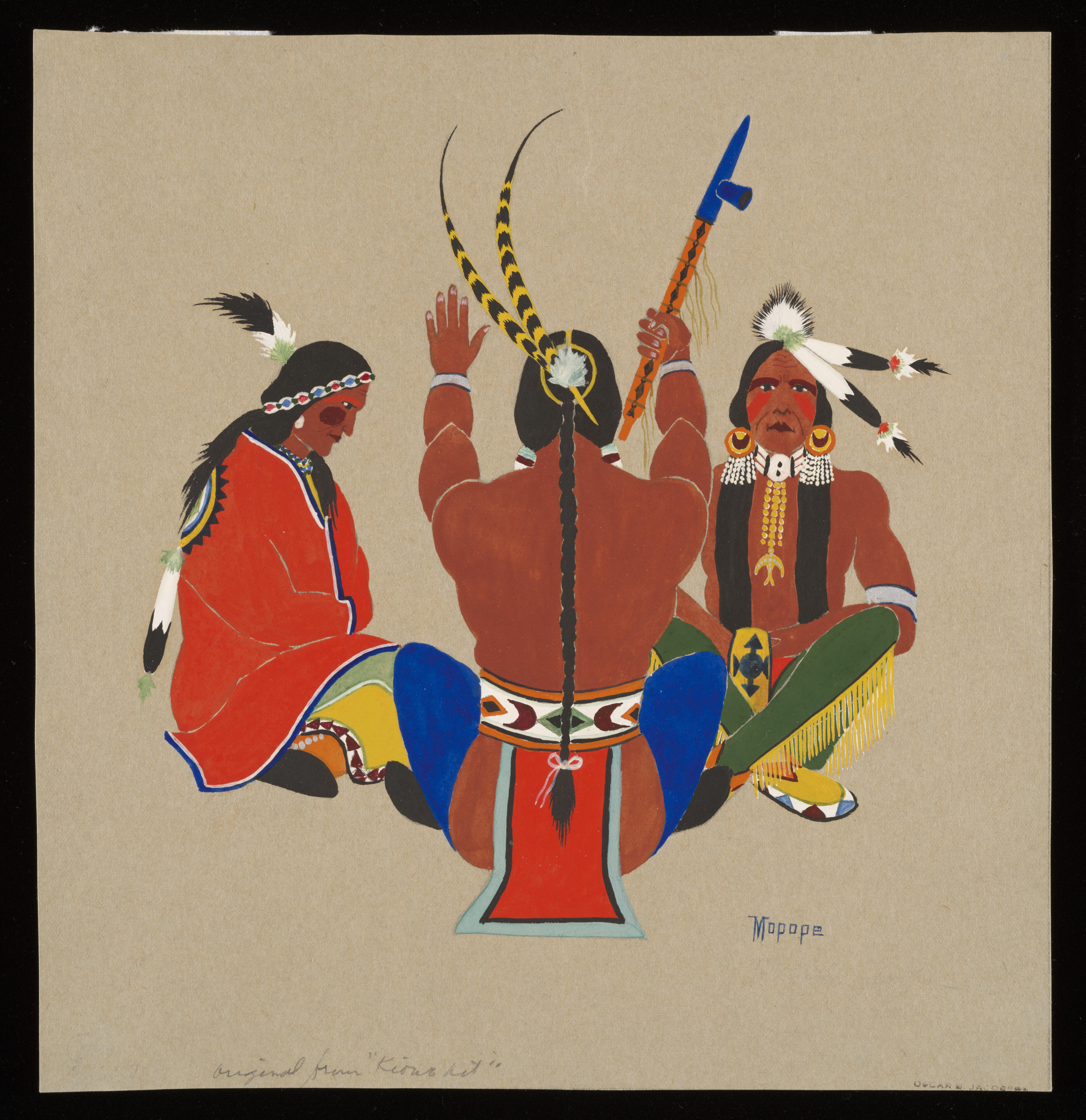Indian Ceremony / Stephen Mopope, August 27, 1898 - February 1974, Native American; Kiowa (Artist)

You may be interested in...
©Gilcrease Museum
Title(s):
Indian Ceremony
Creator(s):
Stephen Mopope, August 27, 1898 - February 1974, Native American; Kiowa (Artist)
Culture:
Native American; Kiowa
Materials/Techniques:
tempera on paper
Paper/Support:
Portrait; one sided
0.231- 0.237 mm
Machine-made, smooth surface, internally dyed grey, mechanical pulp. The image is located on the wire side of the support (consistent wire texture across surface or recto); felt side on verso. Same paper as 02.199.
Classification:
Object Type:
Accession No:
02.202
Previous Number(s):
0227.202; 14471
Department:
Not On View
- Height: 9 11/16in. (24.6cm)
- Width: 9 7/32in. (23.4cm)
Biography:
Stephen Mopope (1898–1974) was born in Redstone, Oklahoma, the son of George Mopope and Etta (Paukeigope) Mopope. Mopope comes from a long lineage of Kiowa (Cáuigù)1 artists, including the ledger artists Silverhorn (1861–1940; also, Silver Horn) and Charles Oheltoint (1852–1934), and master beadworkers Paukeigope (active late 19th century),2 his mother, and Keintaddle (1849–1938), his grandmother. As a boy, Mopope attended St. Patrick’s Mission School in Anadarko, Oklahoma. His child name was Ghoo-Lay-Ee, after his paternal grandfather. He traveled to the University of Oklahoma to study painting in 1927 with a group later called the Kiowa Five (and eventually the Kiowa Six), an artist collective under the tutelage of Professor Oscar Jacobson.Mopope was a skilled dancer and flute player, and an active participant in Kiowa societies, and these experiences manifested as subjects in his paintings. As Mopope’s studio practice flourished, his paintings—along with those of other members of the Kiowa Six—were exhibited internationally, and the Kiowa Six had its artistic debut in 1928 at the International Congress for Art Education, Drawing and Applied Arts in Prague. The collective birthed a movement known as the Kiowa Style of painting, also called Oklahoma Style and Flatstyle, which is recognized by its lack of figural shading, and backgrounds that have a shallow or indistinguishable depth of field. The technique echoes the principles of Mopope’s nineteenth- and twentieth-century artist ancestors, including Oheltoint and Silverhorn. The painting style was later taught at historically Indigenous schools, such as Bacone College (Muskogee, Oklahoma) and Santa Fe Indian School (New Mexico).In 1936 Mopope received a commission from President Franklin D. Roosevelt to paint fifteen murals, including Kiowas Moving Camp, in the Anadarko Post Office. Mopope’s solo career as an artist continued for many years after his work with the Kiowa Six. Gilcrease Museum’s collection of Indigenous paintings has extensive holdings by the prolific artist, including late-career works that incorporate realism and modernism into portraiture and landscape. Mopope’s paintings can be found in both private and public collections, including the Philbrook Museum of Art (Tulsa), the Denver Art Museum, and the National Museum of the American Indian (Washington, D.C.).—Jordan Poorman Cocker, Henry Luce Foundation Curatorial Scholar for Indigenous Painting Collection Research, 2021This text was developed from an interview with Kiowa master artist Vanessa Paukeigope Jennings (also called Vanessa Mopope Jennings), Mopope’s granddaughter, by Jordan Poorman Cocker, May 20, 2020_____________________________1 Cáuigù is the correct identity used by the Kiowa Tribe.2 The Gilcrease collection includes a beaded cradleboard (84.633) by Paukeigope.
Stamped in black ink, "OSCAR B. JACOBSON" in lower right on recto
Handwritten notes are present on artwork
Signed by hand in tempera, "Mopope" in lower right on recto
armbands, belts (costume accessories), blankets (coverings), blue, bracelets (jewelry), breechcloths, ceremonies, chokers, Eagle Feather, Feathers, fringe, green (color), headbands (headgear), headpieces (headgear), Indigenous paintings included in the Henry Luce Foundation 2020-2022 project, Items included in the Henry Luce Foundation 2020-2022 project, Kiowa Five, Kiowa Six, leggings, loincloths, men, mocassins, moccasins, Native American, necklaces, orange, paintings, pipes (smoking equipment), red, Sitting, spirituality, tassels, tempera, tobacco, women, yellow
Stephen Mopope, August 27, 1898 - February 1974, Native American; Kiowa (Artist). Indian Ceremony. 02.202. Tulsa: Gilcrease Museum, https://collections.gilcrease.org/object/02202 (03/19/2019).
Our Online Collections site is a work in progress. If you have information about this item that may be of assistance, please contact us.


